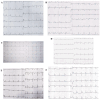A Novel Bradycardia-Associated Variant in HCN4 as a Candidate Modifier in Type 3 Long QT Syndrome: Case Report and Deep In Silico Analysis
- PMID: 40299689
- PMCID: PMC12025296
- DOI: 10.3390/biomedicines13041008
A Novel Bradycardia-Associated Variant in HCN4 as a Candidate Modifier in Type 3 Long QT Syndrome: Case Report and Deep In Silico Analysis
Abstract
Background: Genetic testing for long QT syndrome (LQTS) is straightforward in many families; however, in severe and complex cases, a single disease-causing variant may not be enough to explain all clinical features. In such cases, the search for genetic modifiers may be beneficial for precise diagnosis and management. Case presentation: We describe a three-generational family affected with clinically heterogeneous LQTS type 3 and bradycardia in which a novel missense variant p.V642M in HCN4 was identified in addition to the known pathogenic variant p.E1784K in SCN5A. We performed the detailed clinical investigation of the family and a deep in silico analysis of the discovered variants, showing the causal role of a new HCN4 variant in sinus bradycardia and its possible contribution to the phenotypic heterogeneity of LQTS type 3. Conclusions: This case is the first description of a functional variant in HCN4 as a candidate modifier in LQTS type 3 and demonstrates the importance of analyzing additional genetic variations in families with complex LQTS phenotypes.
Keywords: HCN4; SCN5A; bradycardia; exome sequencing; genetic testing; in silico variant effect prediction; long QT syndrome.
Conflict of interest statement
The authors declare no conflicts of interest.
Figures


Similar articles
-
The Yield of Genetic Testing and Putative Genetic Factors of Disease Heterogeneity in Long QT Syndrome Patients.Int J Mol Sci. 2024 Nov 7;25(22):11976. doi: 10.3390/ijms252211976. Int J Mol Sci. 2024. PMID: 39596046 Free PMC article.
-
HCN4 mutations in multiple families with bradycardia and left ventricular noncompaction cardiomyopathy.J Am Coll Cardiol. 2014 Aug 26;64(8):745-56. doi: 10.1016/j.jacc.2014.05.045. J Am Coll Cardiol. 2014. PMID: 25145517
-
Clinical Presentation of Left Ventricular Noncompaction Cardiomyopathy and Bradycardia in Three Families Carrying HCN4 Pathogenic Variants.Genes (Basel). 2022 Mar 8;13(3):477. doi: 10.3390/genes13030477. Genes (Basel). 2022. PMID: 35328031 Free PMC article.
-
Recent understanding of clinical sequencing and gene-based risk stratification in inherited primary arrhythmia syndrome.J Cardiol. 2019 May;73(5):335-342. doi: 10.1016/j.jjcc.2019.01.009. Epub 2019 Mar 23. J Cardiol. 2019. PMID: 30910390 Review.
-
CACNA1C-Related Disorders.2006 Feb 15 [updated 2024 Dec 19]. In: Adam MP, Feldman J, Mirzaa GM, Pagon RA, Wallace SE, Amemiya A, editors. GeneReviews® [Internet]. Seattle (WA): University of Washington, Seattle; 1993–2025. 2006 Feb 15 [updated 2024 Dec 19]. In: Adam MP, Feldman J, Mirzaa GM, Pagon RA, Wallace SE, Amemiya A, editors. GeneReviews® [Internet]. Seattle (WA): University of Washington, Seattle; 1993–2025. PMID: 20301577 Free Books & Documents. Review.
References
-
- Adler A., Novelli V., Amin A.S., Abiusi E., Care M., Nannenberg E.A., Feilotter H., Amenta S., Mazza D., Bikker H., et al. An International, Multicentered, Evidence-Based Reappraisal of Genes Reported to Cause Congenital Long QT Syndrome. Circulation. 2020;141:418–428. doi: 10.1161/CIRCULATIONAHA.119.043132. - DOI - PMC - PubMed
Publication types
LinkOut - more resources
Full Text Sources
Miscellaneous

